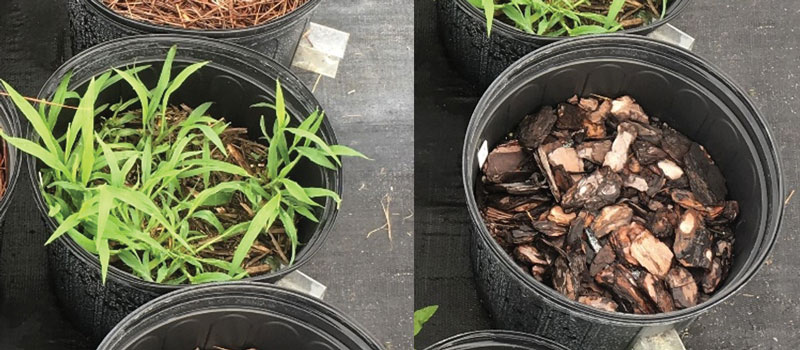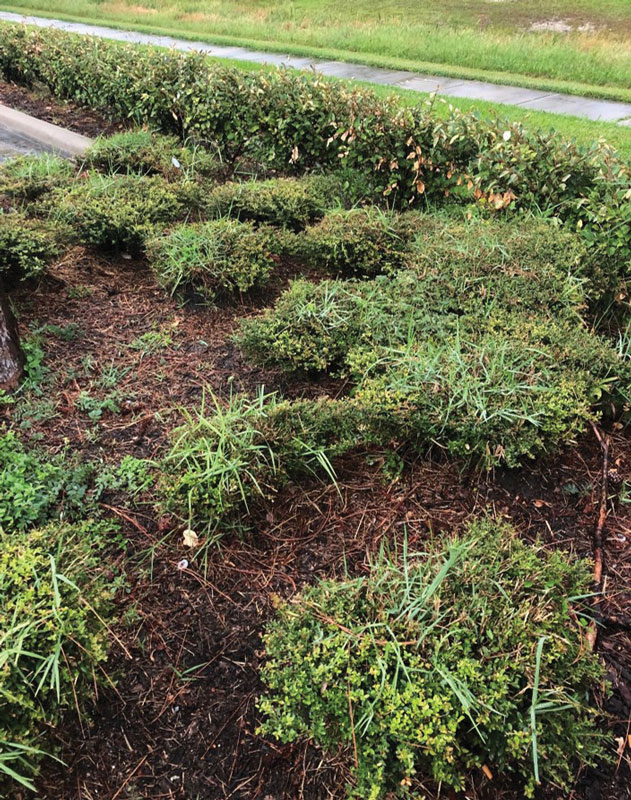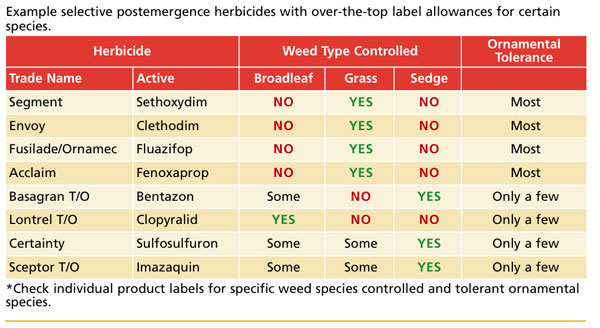8/1/2021
10 Ways to Improve Weed Control in the Landscape
Dr. Chris Marble
While we can sometimes select insect-resistant ornamentals or manage cultural conditions to reduce disease occurrence, weeds are a perennial presence in the landscape and there will be a species or two (or 10) that can thrive in any environment we create. However, there are many effective strategies that can be employed to keep weeds under control.
1. Identify first. There are a lot of really good herbicides that are available nowadays, but before you spray it’s always best to first stop and identify the weed(s) you’re dealing with. Many species have developed resistance or aren’t controlled by some of the most commonly used herbicides.
For example, horseweed (Conyza canadensis) and annual bluegrass (Poa annua) are notorious examples of having developed resistance, while weeds like artillery weed (Pilea microphylla) are commonly misidentified and are not well-controlled by common options. It’ll save a lot of time and effort if you first figure out what you’re dealing with and select the best herbicide (or other strategy) for your situation.
2. Know the weed’s life cycles and how it spreads. Along the same lines of identification, knowing how a weed spreads is also important when selecting your control strategy and can also indicate how serious a weed issue could become with delayed action. Certain species, such as spurges (Euphorbia spp.), spread only via seed, so preemergence herbicides could be a large part of an effective control strategy.
Other weeds, such as dollarweed (Hydrocotyle spp.), spread mostly via rhizomes, an indication that systemic postemergence herbicides are likely needed. There are other species, like woodsorrel (Oxalis spp.), that can spread via seed, rhizomes and stolons that will require a more multi-faceted approach depending on the infestation level. Knowing all of this ahead of time will help you plan, prepare and build a better program.
3.Use the right mulch. Just about any type of mulch—whether it’s pine bark, pine straw, rock or other material—can help reduce weed growth. But all mulches are not created equally. If you have the choice, pick a mulch that’s coarse, such as pinebark mini-nuggets, pinestraw or chipped wood. These coarse mulch products tend to last longer and also dry out faster after a rainfall or irrigation, making them more ideal for the purposes of weed control.
 In contrast, finely shredded wood or other organic materials can still work, but in general, we observe about a 40% increase in weed germination on the top surface of these mulch materials because they hold a lot more moisture a lot longer (Figure 1). You want the mulch to hold moisture in the soil, not in the mulch layer itself.
In contrast, finely shredded wood or other organic materials can still work, but in general, we observe about a 40% increase in weed germination on the top surface of these mulch materials because they hold a lot more moisture a lot longer (Figure 1). You want the mulch to hold moisture in the soil, not in the mulch layer itself.
Figure 1. Example of a finely shredded wood mulch (left) vs. a more coarse pine bark mini-nugget mulch (right) applied at the same depth. Crabgrass seeds were applied on the top surface of each mulch in equal amounts.
4. Use preemergence herbicides. I know many pest control and landscape maintenance companies that are scared to death of spraying a preemergence herbicide anywhere close to a landscape planting bed, but don’t have a second thought about sending in a crew to spot spray weeds in a rose bed with glyphosate (which could result in dire consequences on a breezy day). Preemergence herbicides can definitely cause problems if they’re used incorrectly, but many of the most commonly used options in turfgrass are labeled for over-the-top application to literally hundreds of ornamental plants. They’re much safer to the ornamentals than some people realize and have been shown to significantly reduce maintenance costs by eliminating several spot-spray visits throughout the year, especially during the summer months.
 5. Utilize over-the-top options (when necessary). Depending on the ornamental growth habit or plant spacing, there will likely be times when over-the-top postemergence herbicides will be necessary. A good example would be perennial grasses growing up through the canopy of an ornamental or tall weeds poking through shrub foliage (Figure 2). While options are limited for broadleaf weeds, many plants such as junipers, liriope and ornamental grasses are tolerant to many different herbicides, and there are many different options for grassy weed control in just about all broadleaf ornamentals.
5. Utilize over-the-top options (when necessary). Depending on the ornamental growth habit or plant spacing, there will likely be times when over-the-top postemergence herbicides will be necessary. A good example would be perennial grasses growing up through the canopy of an ornamental or tall weeds poking through shrub foliage (Figure 2). While options are limited for broadleaf weeds, many plants such as junipers, liriope and ornamental grasses are tolerant to many different herbicides, and there are many different options for grassy weed control in just about all broadleaf ornamentals.
Figure 2. Torpedograss (Panicum repens) growing up through the canopy of holly shrubs. These situations call for an over-the-top application of a graminicide (grass
herbicide).
6. Don’t be too reliant on any one postemergence herbicide. The Number 1 rule in weed control (I have several Number 1 rules) is no one herbicide controls all the weeds. Rotate through different postemergence herbicides just as you would for insecticides and fungicides. This will provide better overall control while also preventing/delaying the development of herbicide-resistant weeds and allow the use of some over-the-top applications when necessary (i.e., method #5).
7. Inspect irrigation, maintenance practices and cultural conditions. Nature hates a void and weeds love to fill that void. In the landscape, weeds are often secondary invaders in that they become problematic when the turf is stressed or thinned from disease or insect issues in areas where mulch is thin or plants are spaced far apart, or where groundcover species are struggling to establish. Over/under applying irrigation, mowing too high/low and improper fertilization can all eventually lead to higher weed pressure. Making sure maintenance practices are on point will help keep the landscape more resilient against weeds.
8. Don’t ignore groundcover areas. Use of non-turf groundcovers can be a great low-maintenance addition to any landscape, but because postemergence herbicides can be limited, areas planted with species like liriope, monograss, creeping junipers, Asiatic jasmine or sedums can be quickly overrun with weeds. Although postemergence options are limited, many preemergence herbicides are safe for use in these areas. If possible, planting certain species more densely at installation can also decrease establishment time and help reduce weed growth.
 9. Develop a program and apply herbicides as a rotation. Different weeds will be problematic at different times of the year, so naturally, different herbicides will often be needed at different times of the year as well. Determine which weeds are most problematic each season and design your program (i.e., rotation) around that, choosing pre- and postemergence herbicides as appropriate. A great guide that includes information on just about all of the herbicide options, along with efficacy tables and information on how to build a rotation, can be found in the 2017 Southeast Pest Management Guide for Nursery Crops and Landscape Plantings at ces.ncsu.edu.
9. Develop a program and apply herbicides as a rotation. Different weeds will be problematic at different times of the year, so naturally, different herbicides will often be needed at different times of the year as well. Determine which weeds are most problematic each season and design your program (i.e., rotation) around that, choosing pre- and postemergence herbicides as appropriate. A great guide that includes information on just about all of the herbicide options, along with efficacy tables and information on how to build a rotation, can be found in the 2017 Southeast Pest Management Guide for Nursery Crops and Landscape Plantings at ces.ncsu.edu.
10. Combine all tactics and use an integrated approach. An integrated approach that utilizes a combination of non-chemical and chemical options is going to provide the best results. Combining tactics 1 through 9 into a holistic program will work to keep weeds at bay in any landscape situation. GT
Dr. Chris Marble is Assistant Professor—Ornamental, Landscape and Invasive Weed Management at the University of Florida
Mid-Florida Research and Education Center in Apopka, Florida.